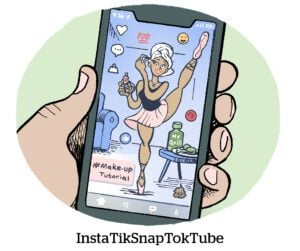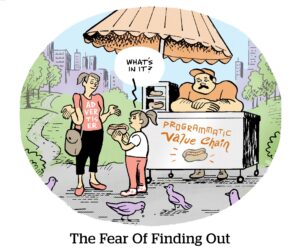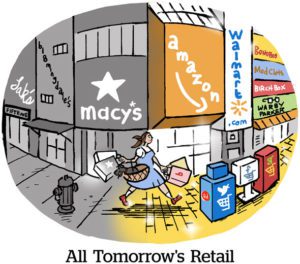Here’s today’s AdExchanger.com news round-up… Want it by email? Sign up here.
On The Spot
Spotify added 10 million subscribers since last year, bringing its total to 220 million paid users.
Most streaming TV services would hire a troupe of trumpeters to announce that news. For Spotify, though, it isn’t enough to assure investors of a profitable future.
The company’s stock tanked roughly 15% after reporting its Q2 results on Tuesday.
Although Spotify is increasing its subscription price, it has an intractable problem in the form of relatively low ad growth, considering that 330 million people use its free ad-supported tier.
And adding new ad-supported users won’t necessarily help.
Founder and CEO Daniel Ek warned investors that Spotify is adding users outside of the US, which is a region with high average revenue per user.
Ek’s point is that skewing international means Spotify’s ARPU will be lower than social media or other major ad platforms that don’t overindex in non-US markets.
But here’s the glass-half-full view: Other social channels with strong user growth likewise had relatively low ARPU rates after releasing popular products, because it takes time for advertisers to follow the audience.
“It’s more of a lag than anything else,” Ek said.
A Commanding Performance
Google is encountering pushback against its machine learning-based ad products, with Performance Max drawing more ire.
The main issue is that PMax advertisers must serve ads across Google’s portfolio with almost no control or transparency. (To be fair, there are controls for branded searches if advertisers want to restrict Google from bidding against their own name or product terms.)
But Google has been equally clear that, although it’s still testing PMax and remains open to feedback – and even to making some concessions – the PMax approach is how Google plans to approach its ad products going forward.
Yesterday, for instance, Google Ads customers who use Dynamic Search Ads or Google Display campaigns (which is to say, everyone) began to see “self-upgrade tools” that convert those single-channel campaigns to PMax campaigns instead.
Unlike Google Maps ads or Google Smart Shopping campaigns served via PMax, these are voluntary changes.
But it’s telling that the word “upgrade” is used 12 times in Google’s blog post as shorthand to explain the shift from Dynamic Search Ads and/or Google Display campaigns to PMax. Those small “upgrades” actually represent important, fundamental shifts in how and where advertisers spend their money.
DOOH-ing It
Digital out of home (DOOH) is having a moment.
Over the past year, the number of DOOH-enabled screens increased by 37%, according to new research from Place Exchange.
Food and drink, personal finance and health and fitness advertisers accounted for almost half of programmatic out-of-home (OOH) spend during that period.
The category as a whole bounced back quicker than expected from a deep pit in 2020 and 2021. GroupM forecasts DOOH to grow 26.1% to just over $13 billion this year, and to represent 43% of all OOH revenue by 2028.
What keeps the DOOH train revving? There are three factors at play, Place Exchange CEO Ari Buchalter tells AdExchanger.
- The DSPs that advertisers and their agencies already use are making it easier to execute DOOH campaigns.
- DOOH has experienced measurement improvements that put it on par with other digital channels.
- Buyers are tired of being sold a bill of goods on the web.
“We are seeing a ‘flight to quality,’” says Buchalter, noting that programmatic buyers are fed up with online fraud, privacy issues and brand safety violations.
Meta’s New Crew
Lots of changes have occurred recently in Meta’s upper ranks.
Amid mass layoffs and CEO Mark Zuckerberg’s “year of efficiency,” numerous high-profile veterans have departed the company formerly known as Facebook.
Dan Levy, Meta’s VP of business messaging and a former top ad leader, left in March after 14 years. Meanwhile, VP Nada Stirratt moved on at around the same time and was recently replaced by longtime Meta executive Alvin Bowles, who was promoted to VP of the company’s global business group for the Americas.
Those are just two examples. Here are 12 others, per Insider.
Meta often elevates people from within its ranks to fill open roles. But now there’s someone new joining its upper echelon: Andrea Gellert, Meta’s incoming VP of global business and product marketing.
Gellert replaces Michelle Klein, who left Meta earlier this year, and joins from point-of-sale SMBs solutions provider Clover.
As the world turns, et cetera.
Keeping with the Meta theme, the company reports its second quarter earnings tonight after the stock market closes.
But Wait, There’s More!
TikTok introduces text-only posts. [NYT]
Snap shares plunge 16% on a weak forecast. [CNBC]
ATT lawsuit: France’s antitrust watchdog is suing Apple for allegedly abusing its dominant App Store position to unfairly track iOS users for advertising purposes. [Bloomberg]
Threads users are already dropping off. [Marketing Brew]
Criteo adds IAS as its first retail media viewability and invalid traffic detection provider. [release]
Investors say they’re fed up with Amazon’s big bets. [The Information]
You’re Hired!
T-Mobile hires Brad Stamulis as VP of marketing. [post]















